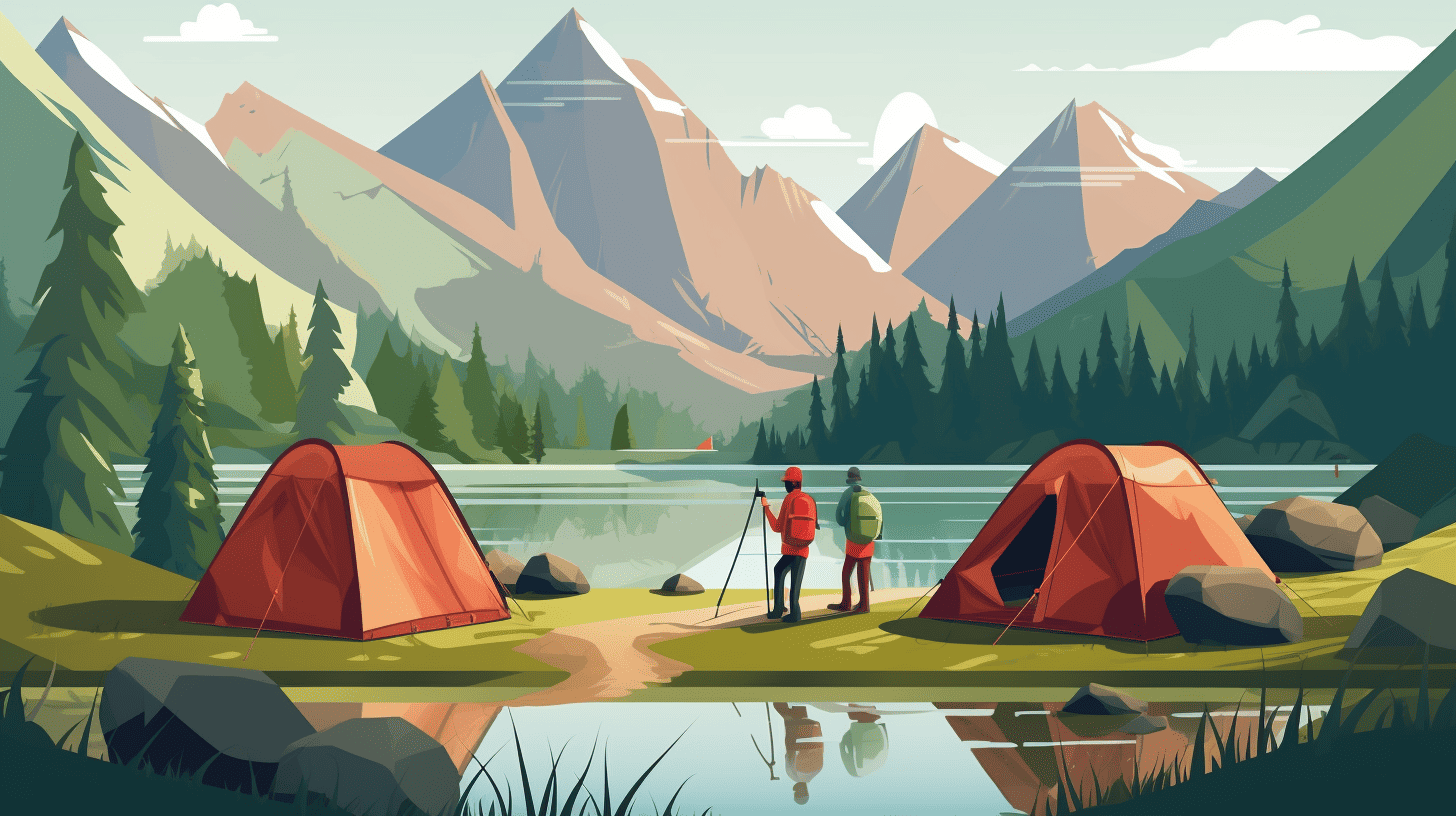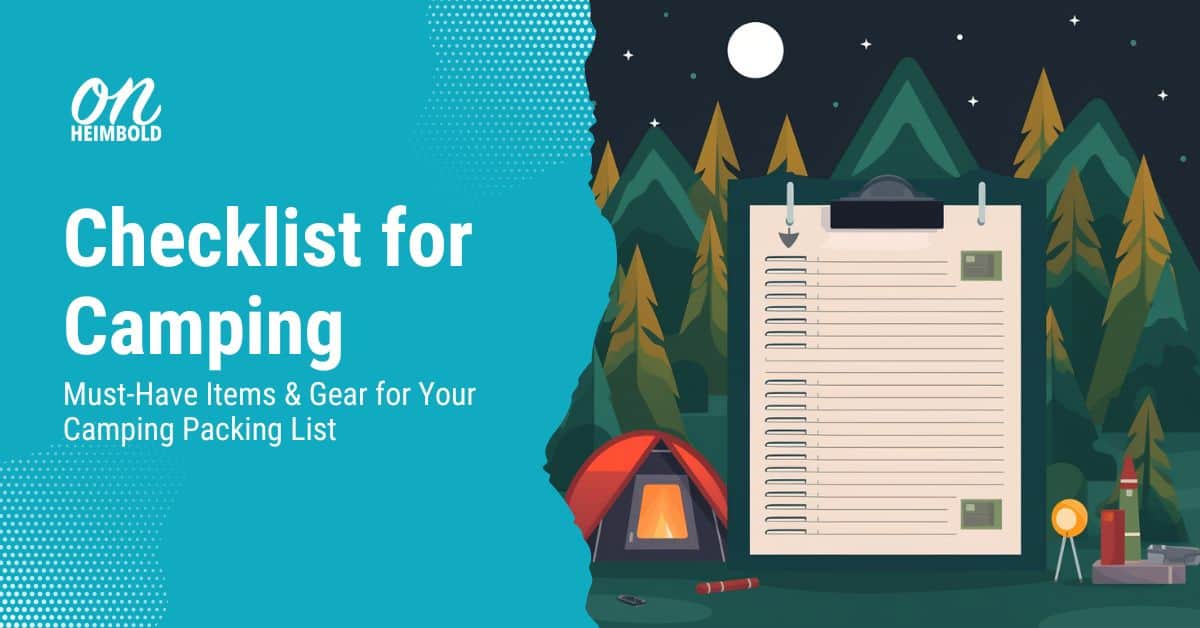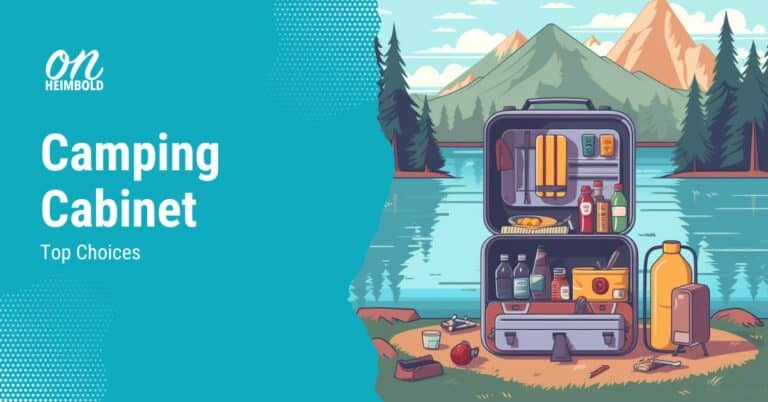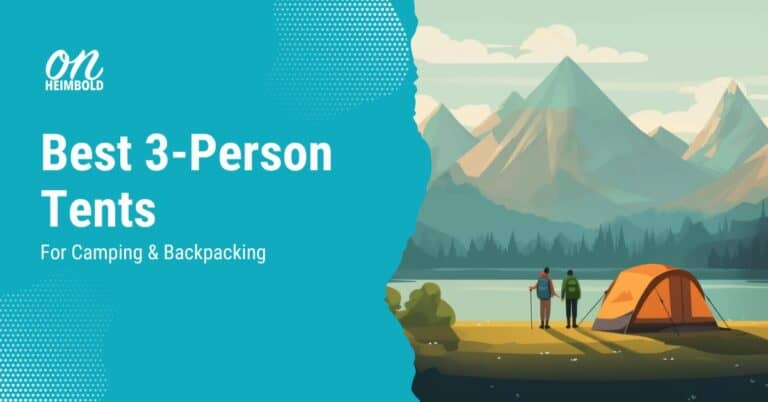Avoid Disaster with the [Essential] Checklist for Camping
Checklists are essential for any activity, but especially for camping. There are so many things you need to think about and remember when packing for a camping trip, from the big items like tents and sleeping bags to the smaller details like flashlights and extra batteries.
A good checklist will help you make sure you don’t forget anything important, and can also help calm your nerves by giving you a sense of control over the situation. So without further ado, here is our essential checklist for camping:
Don’t Regret It: Essential Gear to Pack as Checklist for Camping
Part 1:
| SLEEPING & COMFORT | ILLUMINATION | CAMP KITCHEN | OPTIONAL COOKING EXTRAS |
|---|---|---|---|
| ☐ Tent for camping | ☐ Lantern for camping | ☐ Stove for camping and its fuel | ☐ Firewood and fire starter |
| ☐ Ground cloth/Footprint | ☐ Headlamp (with extra batteries) | ☐ Cooler filled with ice | ☐ Hatchet or axe |
| ☐ Sleeping mat and bag | ☐ All necessary cookware and utensils | ☐ Portable maker for coffee/tea | |
| ☐ Liner for sleeping bag | ☐ Supplies for food preparation and dish-washing | ☐ Water jugs | |
| ☐ Pillow for camping | ☐ Camp table and tablecloth | ||
| ☐ Camping chair and optional hammock | |||
| ☐ Extra stakes | |||
| ☐ Optional sunshade |
Part 2:
| CLOTHING & FOOTWEAR | OPTIONAL APPAREL | HYGIENE & HEALTH | PERSONAL ITEMS & OTHER EXTRAS |
|---|---|---|---|
| ☐ Baselayer clothing | ☐ Gloves and beanie | ☐ Toiletries for personal use | ☐ Repair kit for basic fixes |
| ☐ Insulated jacket (down/synthetic) | ☐ Cap or hat | ☐ Protection against sun and bugs | ☐ Navigation tools (map, compass, GPS) |
| ☐ Rainwear jacket | ☐ Sandals or slippers for camp | ☐ Trowel or portable toilet (optional) | ☐ Bottle for water |
| ☐ Hiking pants or shorts | ☐ Swimsuit | ☐ Optional portable/solar shower | ☐ Mask for eyes and earplugs |
| ☐ Footwear for hiking (boots or shoes) | ☐ Long underwear and sleepwear | ☐ Sun hat | ☐ Extra batteries or solar charger |
| ☐ Hiking socks | ☐ Neck gaiter/buff | ☐ Baby wipes | ☐ Notebook and pen/pencil |
| ☐ Reading material (book or Kindle) | |||
| ☐ Games for camping | |||
| ☐ Gear specific to planned activities | |||
| ☐ ID, cash, and cards | |||
| ☐ Mobile phone and charger | |||
| ☐ Confirmation of campsite reservation | |||
| ☐ Relevant park or Forest Service pass | |||
| ☐ Bear spray (if required) |
Campsite & Sleeping:
Camping can be a fun and exciting adventure if you have the right equipment. Here’s a concise guide on the necessary items to include in your camping checklist for the campsite and sleeping section:
Campsite:
- Tent with footprint and stakes
- Portable hammock or ground cloth
- Mallet for driving tent stakes
- Extra tarp if backpacking to campsite
- Camp chairs
- Camp table with tablecloth
- Lantern, headlamps, and string lights
- Windbreak
Sleeping:
- Sleeping bag
- Sleeping bag liner or blanket
- Pillow
- Sleeping pad or camp bed if tent camping
- Bedding (sheets, blankets)
- Air pump for air mattress
- Mattress pump (optional)
For a comfortable camping experience, it’s best to choose camping chairs that are sturdy, lightweight, and foldable. A good camping table should be portable and easy to set up. A lantern with fuel or string lights can create a cozy atmosphere for lighting.
Remember to check your campground amenities before you pack, as most drive-up campgrounds will provide a picnic table and firepit and sell locally sourced firewood on-site. With these items in tow, you can set up a comfortable campsite and enjoy a good night’s sleep under the stars. Happy camping!
Tools & Repair Items:
Camping can be a fun and relaxing activity, but it’s important to ensure you have the right tools and repair items to ensure a safe and enjoyable trip. Here are some essential items to include in your camping checklist:
Tools:
- Multi-tool: a versatile tool that can be used for various applications.
- Axe and saw: for cutting firewood and setting up your tent.
- Duct tape: for quick repairs on gear and equipment.
- Paracord and bungee cords: for securing gear and equipment.
- Small trowel: for waste disposal.
Repair Items:
- Tenacious Tape gear repair tape: for repairing tears and holes in gear and equipment.
- Sil-nylon patches: for repairing tents and tarps.
- Tent pole splint: for repairing broken tent poles.
- Air mattress repair kit: for repairing punctures in air mattresses.
- Seam sealer: for repairing leaks in tents and tarps.
In addition to these essential items, make sure also to pack other camping necessities such as a headlamp or flashlight, tarp, rope or bungee cords, waterproof matches, and a stove or BBQ with fuel. Don’t forget also to pack cooking and eating utensils, a sleeping bag, an air mattress or sleeping pad, and insect repellent. With these essential tools and repair items, you’ll be prepared for any situation that may arise during your camping trip.
Camp Kitchen & Cooking:
When packing for your camping trip, including the essential items for your camp kitchen is important. Start by planning your meals beforehand to ensure you have everything you need.
- Camp stove
- Fuel for stove
- Fire Grill Grate
- Pots and pans
- Utensils
- Good knife
- Mess kit (plate, bowl, and eating utensils)
- Portable coffee maker
- Biodegradable soap
- Sponge
- Bear canister or metal locker for food storage
- Cooler
- Resealable plastic bags for food storage
- Tablecloths and clips for picnic tables (optional)
By packing these items, you’ll have a well-equipped camp kitchen and be prepared to cook and enjoy delicious meals in the great outdoors.
Clothing & Footwear:
When it comes to camping, packing the right clothing and footwear is crucial to ensure a comfortable and safe trip. Here’s a concise guide to help you pack the essentials:
- Pack versatile and comfortable clothing items that can be layered and adjusted according to the weather conditions.
- Include waterproof jackets, pants, and an umbrella to stay dry in case of unexpected rain.
- Pack hiking boots or shoes that provide good support and grip on the terrain.
- Don’t forget warm socks, hats, and gloves for chilly nights.
- Sunglasses are a must to protect your eyes from the sun’s glare.
- Pack extra clothing items in case of unexpected weather changes or accidents.
- Prioritize comfort and functionality over fashion when selecting clothing items.
- Remember to pack appropriate footwear for the terrain.
By following these tips, you can ensure that you have a comfortable and enjoyable camping experience. Happy camping!
Health & Hygiene:
When planning your camping trip, it’s important to include essential health and hygiene items in your checklist to stay clean and healthy in the great outdoors. Here are some must-have items to consider:
- Hand sanitizer: Keep your hands clean and germ-free, especially before eating or handling food.
- Wet wipes: Perfect for quick clean-ups and freshening up after a hike or outdoor activity.
- Insect repellent: Protect yourself from pesky bugs and insects that may carry diseases.
- Sunscreen: Avoid sunburn and skin damage with SPF 30 or higher.
- Toilet paper: Essential for obvious reasons, especially when camping in areas without restrooms.
- Toothbrush and toothpaste: Keep your teeth and gums healthy by brushing regularly.
- Biodegradable soap: Use for washing dishes and personal hygiene, and ensure it’s environmentally friendly.
- First aid kit: Be prepared for any minor injuries or accidents that may occur during the trip.
Remember also to pack any prescription medications you need and any other toiletries you would usually use. Keeping yourself clean and healthy is important when camping, so don’t forget these essential items. Happy camping!
Personal Items & Extras:
When packing for a camping trip, it’s important to make sure you have all the necessary personal items and extras. Here are some categories to consider:
Personal Hygiene: Toothbrush, toothpaste, soap, shampoo, conditioner, deodorant, razor, feminine products, toilet paper, shower shoes/flip flops, towels/washcloths, and any other toiletries you typically use.
First Aid: First aid kit, any necessary medications, insect repellent, sunscreen, and lip balm.
Entertainment: Books, board games, playing cards, Frisbee, and any other items that will keep you entertained during downtime.
Miscellaneous: Backpack or day pack, camera, binoculars, flashlight or headlamp with spare batteries, wallet, notebook and pencil, sunglasses, phone charger, hand sanitizer, and any permits or reservations needed for your trip.
When packing, prioritize the essentials, such as personal hygiene and first aid items. Entertainment and miscellaneous items can be added based on personal preference and the nature of your trip. Remember to check the weather forecast and pack appropriate clothing and gear. Following these guidelines will prepare you for a successful camping trip.

How to create an optimized checklist for camping
| Step | Description | Example Tasks |
|---|---|---|
| 1. Research Your Needs | Determine your priorities based on factors like location, season, and duration of the trip. | Are you going to a campground or primitive site? What activities do you want to do? What facilities are available at the site? |
| 2. Make a List of What You Need | List all essentials you need for your trip. Categorize them into groups. | Food: cooking camp stove, utensils, plates. Shelter: tent, sleeping bag. Clothing: layers for climate and weather conditions. |
| 3. Check Off Items As You Pack Them | Create a comprehensive checklist, group similar items, and mark off items as you pack them. | Use storage bins for camping gear. Have duplicate camping versions of items. Double-check your list before leaving. |
| 4. Follow the Order of the List | Group items by their purpose or usage order. Check off each item as you pack. | Use a spreadsheet or camping app for organization. Adjust the order based on your preferences and camping style. |
| 5. Include a Copy of Your Checklist Somewhere Safe | Keep a backup copy of your checklist to avoid forgetting essential items. | Store a backup copy in a waterproof container or an online storage service. Keep a digital version like a PDF or Excel spreadsheet. |
| 6. Keep Track of Time Spent on Each Item | Monitor the time spent on each item to prioritize and allocate your time efficiently. | Group items by category and estimate the time needed for each category. Mark off items that are already packed. |
| 7. Make Sure Everything is Packed Correctly | Pack your camping gear efficiently using various tools and strategies. | Use a checklist, storage bins, packing cubes, dry bags, and compression bags. Pack a camping tub with essentials. |
| 8. Review Your Checklist Regularly | Regularly review and update your checklist to ensure it remains relevant and useful. | Review at least once every camping season or before any trip. Seek input from fellow campers. Update your checklist accordingly. |
Step 1: Research your needs
When creating a camping checklist, it’s important to prioritize your needs based on factors such as location, season, and duration of the camping trip. Start by gathering the important basics like your shelter and bedding first, then expand from there. To determine what gear you need to bring on your trip, ask yourself these 3 questions:
Are you going to a campground or a primitive campsite?
What activities would you like to do?
What facilities does your campsite provide?
The Dyrt is a great place to research campsites, where you can see what amenities the campground offers, see photos, and read other camper’s reviews. Other reliable sources to consult are REI and OutdoorGearLab.
When packing, keep a few things in mind: what facilities does your campsite provide?
For example, if there are no showers, you might want to add a sun/solar shower to your list. Finally, always leave a detailed trip schedule with a responsible person back home, and consider renting or borrowing big-ticket items to get you started.
Step 2: Make a list of what you need
Step 2 in creating an optimized checklist for camping is to make a list of everything you need for your trip. Categorizing items into groups such as food, shelter, and clothing is important.
Consider bringing a cooking camp stove, pots and pans, eating utensils, and plates or bowls for food. For shelter, bring a tent, sleeping bag, and sleeping pad. For clothing, pack appropriate layers for your destination’s climate and weather conditions.
When prioritizing items, consider the length and location of your camping trip. Focus on bringing the essentials if you’re going on a short trip. Consider bringing extra supplies and gear if you’re going on a longer trip. Additionally, think about the facilities available at your campsite, such as showers or bathrooms, and adjust your list accordingly.
Remember, this list is just a starting point and should be customized to fit your specific needs and preferences. Being prepared and organized can ensure a fun, comfortable, and stress-free camping trip.
Step 3: Check off items as you pack them
To effectively check off items as you pack for camping, start by creating a comprehensive checklist. Group similar items together and prioritize essential items like shelter, bedding, and cooking equipment. Use storage bins like an Action Packer to keep all your camping gear together in a dedicated area.
Consider buying duplicate camping versions of small inexpensive items like cooking utensils and silverware, so you don’t forget anything important. Once you start packing, use your checklist to mark off items as you go. If you use a simple camping checklist, mark the ‘already packed’ items so you know what you have.
Before leaving for your trip, double-check your list to ensure that you haven’t forgotten anything important. You can also put a note on top of your bin of anything that got taken out so you remember to replace it when you camp again.
By following these tips, you can pack and organize all your camping gear efficiently and effectively.
Step 4: Follow the order of the list
Following the order of your camping checklist can make your camping experience more organized and stress-free. To begin, group items by their purpose or by the order in which they will be used. For example, group items for shelter and bedding first, followed by cooking and food, then personal items and activities.
Consider using a spreadsheet or a dedicated camping app to organize the list physically. As you pack, check off each item to ensure you don’t forget anything.
Review and adjust the order of your list based on your personal preferences and camping style. For instance, if you prefer to set up your campsite first, group all the items needed for that task together.
By following a logical order, you can avoid the frustration of having to dig through your bags or bins to find what you need.
Step 5: Include a copy of your checklist somewhere safe
Keeping a backup copy of your camping checklist in a safe place is crucial to avoid the potential consequences of forgetting essential items. Losing or damaging your only copy can lead to frustration and ruin your camping experience.
Consider storing a backup copy in a waterproof and fireproof container or an online storage service accessible from anywhere. A suitable format for the backup copy is a digital version, such as a PDF or an Excel spreadsheet. Don’t risk forgetting something important and always have a backup copy of your camping checklist.
Step 6: Keep track of time spent on each item
It’s important to keep track of time spent on each item when creating a camping checklist because it helps you to prioritize and allocate your time efficiently. Knowing how much time each item requires allows you to plan accordingly and avoid last-minute rushing.
To optimize your checklist, consider grouping items by category and estimating the time needed for each category. You can also mark off items that are already packed and keep a note of anything that needs to be replaced.
By doing so, you can streamline your packing process and make your camping trip more enjoyable.
Step 7: Make sure everything is packed correctly
Packing for a camping trip can be overwhelming, but with a little planning and organization, it doesn’t have to be. Here are some tips to help you pack your camping gear efficiently and effectively:
- Use a checklist: A checklist for camping can help you remember everything you need to bring and keep track of what you have already packed.
- Store gear together: Store all your camping gear together in a dedicated area or in storage bins. This way, you don’t have to go hunting around the house to track everything down before your trip.
- Use packing cubes: Packing cubes are a great way to keep your clothes organized in your backpack. Group clothes together by type or by day so you can easily grab what you need.
- Distribute weight properly: Make sure to distribute weight evenly in your backpack. Pack heavier items closer to your back and lighter items towards the top.
- Pack duplicates of small items: Consider buying a duplicate camping version of small items like cooking utensils or silverware so you don’t forget anything.
- Don’t forget the essentials: Make sure to pack your cell phone, wallet, keys, lip balm with SPF, all licenses and permits, a copy of your campsite reservation confirmation, an insulated water bottle, and a travel-sized umbrella.
- Use dry bags: Use full-size dry bag liners inside your backpack and smaller dry bags for delicate items. Organize your kit inside your pack using Zip-loc bags or light storage bags.
- Pack a cutting board: Pack a cutting board to contain your mess and avoid spilling anything onto the ground.
- Use compression bags: Use compression bags to keep your items safe, secure, and portable if you pack many miscellaneous items.
- Keep a camping tub: Keep a camping tub with bug spray, flashlights, matches, and a first aid kit. The less items you need to gather for each camping trip, the easier and less stressful packing will be.
Remember, packing for a camping trip doesn’t have to be complicated. By following these tips, you can pack efficiently and effectively, ensuring that you have everything you need for a successful camping trip.
Step 8: Review your checklist for camping regularly
Regularly reviewing your camping checklist is crucial to ensure that you have all the necessary supplies and equipment for a successful outdoor adventure. It is recommended to review your checklist at least once every camping season or before any trip to identify any items that need to be added or removed.
One effective method is to go through your checklist item by item and assess its importance and relevance to your upcoming trip. Consider factors such as the type of camping, activities planned, location, time of year, and length of the trip.
You can also seek input from fellow campers to identify any items that may have been overlooked. Remember to update your checklist accordingly and make sure to pack everything before heading out.
With a well-maintained checklist, you can enjoy your camping trip with peace of mind knowing that you have everything you need.

Final Advice For Your Camping Checklist
Before embarking on your camping trip, it is important to have a plan in case of emergency situations. Make sure to inform someone of your itinerary, including where you will be camping and when you plan to return. Pack a well-stocked first aid kit and familiarize yourself with basic wilderness first aid techniques. It is also a good idea to research the area where you will be camping and be aware of any potential hazards.
To keep your gear organized, consider using clear plastic bins or dry bags to store your items. Label them accordingly and pack them in a logical order for easy access. This will save you time and frustration when setting up camp and looking for specific items.
Lastly, remember to leave no trace. This means packing out all of your trash, being mindful of where you set up camp, and respecting the natural environment. Follow the principles of Leave No Trace to minimize your impact on the wilderness and ensure that it remains pristine for future generations to enjoy.
By following these tips and using our comprehensive camping checklist, you can have a stress-free and enjoyable camping experience. Happy camping!
FAQ for camping checklist
What type of tent is best for camping?
For camping, consider dome, cabin, or backpacking tents. Dome tents are lightweight and versatile, cabin tents are spacious but bulkier, and backpacking tents are easy to carry but smaller. Choose based on your group size, expected weather, and setup ease. Ventilation and weatherproofing are crucial for comfort.
What type of camping stove should I bring?
Consider propane stoves for camping due to their effective heat output and wind resistance. Regular campers might prefer stoves with reusable tanks to reduce waste. For backpacking, opt for ultralight stoves, which are compact and can utilize small fuel canisters or solid fuel tablets for convenience and portability.
What kind of clothing should I bring camping?
When camping, opt for layered clothing to adjust to changing temperatures. Include moisture-wicking base layers, insulating mid-layers, and waterproof outer layers. Don’t forget sturdy footwear, a sun or cold protection hat, and gloves. Pack extra socks, and consider the climate and activities when selecting your camping attire.
What kind of footwear should I bring camping?
For camping, choose sturdy, waterproof hiking boots for uneven terrain and protection from elements. If you plan on water activities, consider quick-drying water shoes. In colder climates, insulated boots are beneficial. Always prioritize comfort and fit to prevent blisters, and break in new footwear before your trip.
What type of first aid kit should I bring camping?
Bring a camping-specific first aid kit containing bandages, gauze, antiseptic wipes, tweezers, medical tape, pain relievers, and any personal medication. Also include items for common outdoor ailments like insect sting relief, antihistamines, and a snake bite kit if in a relevant area. Remember, knowledge of basic first aid is crucial.
What is a must-have for camping?
Essential camping items include a durable tent, sleeping bag, camping stove, water purifier, and appropriate clothing and footwear. Survival items like a multi-tool, flashlight, fire starter, emergency blanket, map, compass, and a comprehensive first aid kit are also crucial. Always tailor your gear to the environment and weather.
What does every girl need for camping?
For camping, every girl needs a durable tent, appropriate sleeping bag, cooking equipment, and water purification system. Wear layers to adapt to changing temperatures and sturdy footwear. Personal essentials might include hygiene items like biodegradable soap, feminine products, and a compact mirror. A first aid kit and survival items are also crucial.
How do beginners prepare for camping?
Beginners should first research the camping site, understanding its facilities and rules. Pack essentials like a tent, sleeping bag, cookware, food, water purifier, and weather-appropriate clothing. Bring a first aid kit and learn basic first aid. Practice setting up your tent and stove beforehand. Always inform someone about your trip details.
What items are essential for camping alone?
When camping alone, essential items include a one-person tent, sleeping bag, compact cookware, and a water purifier. Also, pack survival gear like a multi-tool, flashlight, fire starter, map, compass, and a comprehensive first aid kit. A personal locator beacon or satellite communicator can be crucial for emergencies, alongside a charged mobile phone.
What should I bring to camp at night?
For night camping, you’ll need a reliable tent, sleeping bag, and possibly an insulated sleeping pad for colder climates. Bring a headlamp or flashlight with extra batteries for visibility. Pack warm clothing, and consider a campfire-ready kit if allowed. Don’t forget insect repellent and a first aid kit for safety.
How do you keep camping simple?
To keep camping simple, stick to basics. Bring a straightforward tent, sleeping bag, basic cookware, and essential clothing. Choose easy-to-cook food or pre-made meals. Use a map and compass for navigation instead of complex GPS devices. Focus on enjoying nature rather than bringing lots of gear. Remember, less can be more.







